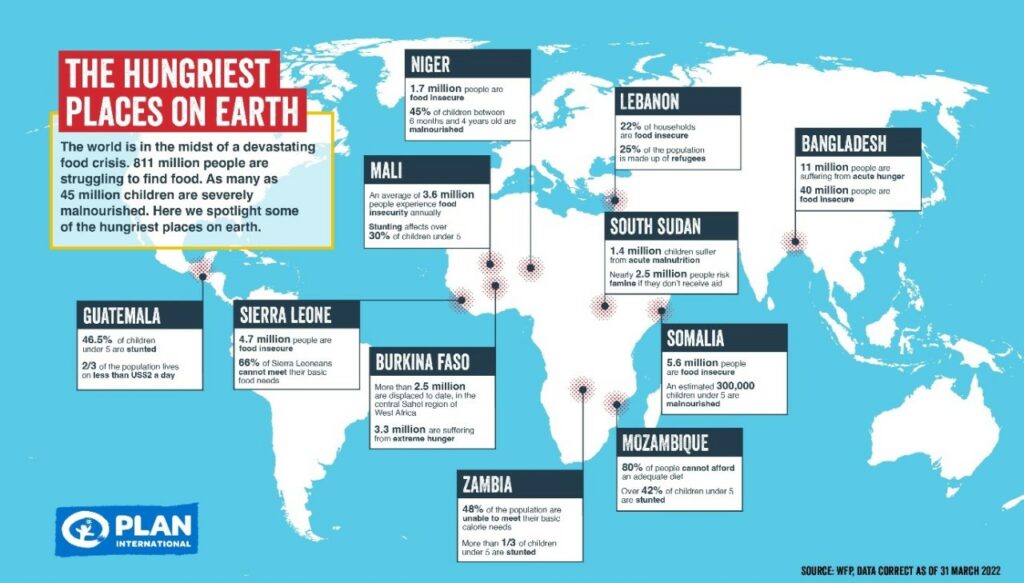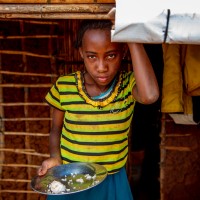The world is in the midst of a devastating food crisis. Across the globe, in countries such as Mali, Bangladesh and South Sudan, conflict, climate shocks and COVID-19 are contributing to a dramatic escalation in food insecurity.
As the current devastating crisis in Ukraine escalates, one of its aftershocks has been a rapid increase in food prices and fuel costs which can only worsen the global hunger situation. As food supply chains break down, and prices escalate at a pace not seen for decades, Plan International warns that time is running out for children, especially girls, living in hunger hotspots globally.

“Famine is quite literally knocking on the door,” says Dr Unni Krishnan, Global Humanitarian Director, Plan International. “Ukraine’s harvest normally feeds 400 million people and with every day that conflict continues the devastating ripples are felt far and wide with rapidly increasing food prices making a bad situation extremely grave. Acting early saves lives, and the time to act is now.”
According to the UN, some 928 million people were severely food insecure last year – an increase of 148 million on the previous year. In countries already facing growing hunger, one in eight people – many of them women and children – will go to bed hungry tonight, and 44 million people are now on the brink of starvation, facing famine or famine-like conditions. As many as 45 million children are suffering from the most acute form of malnutrition. The UN has warned that unless life-saving humanitarian assistance is urgently stepped up, 300,000 people could starve to death every single day.
“The Central Sahel region of West Africa, already stricken by hunger, relies heavily on import of wheat, a supply chain heavily disrupted by the Ukraine crisis,’ adds Sven Coppens, Director, Plan International, Coastal West Africa. “The conflict in Ukraine will trigger even higher food prices, meaning it can only worsen the hunger crisis in countries here such as Burkina Faso, Mali and Niger.”
In 2022, over 61 million people were already projected to require humanitarian assistance and protection in the West and Central Africa region. The number of food insecure people has been on the rise there, with more than 22 million people food insecure, and 2021 saw a drastic increase in humanitarian needs in the Central Sahel.
On the other side of the continent, more than 20 million people in Ethiopia, Kenya and Somalia are in urgent need of food and water. Millions of families’ harvests have failed, while thousands of their livestock – which pastoral families rely upon for sustenance and livelihoods – are emaciated or dead.
Food prices in the Horn of Africa have for many months been rising in drought-affected areas, due to a combination of macro-economic challenges and below-average harvests, leaving families unable to afford even basic items. Meanwhile, many water points are dry, forcing women and girls to walk longer distances to access water and increasing the risk that they may face gender-based violence.
Meanwhile in other parts of the world such as Guatemala and Lebanon, families find themselves unable to survive unless they take their children out of school, so they can work to bring in an income.
While the effects of food insecurity are felt across communities, the impacts on adolescent girls are often unacknowledged. Girls are being exposed to new risks of sexual exploitation, abuse, violence, and harassment during food distributions, while having their wellbeing and future prospects undermined by being taken out of school and made to work.
When food is scarce, girls often eat less and eat last. As families increasingly resort to negative coping mechanisms, pre-existing child protection problems become more acute and widespread. Girls are at heightened risk of being removed from school, of child, early and forced marriage, early pregnancy, and of sexual exploitation, as families and communities come under the strain of increased food insecurity. Women, infants, adolescents and children are also particularly vulnerable to malnutrition.
Plan International is responding to the hunger crisis in 17 global hunger hotspots, providing programme responses including school feeding, cash and voucher assistance, cash-based transfers and food distribution.
We have a total of 60 projects with the World Food Programme in 15 countries, which currently directly reach 3.2 million people.

